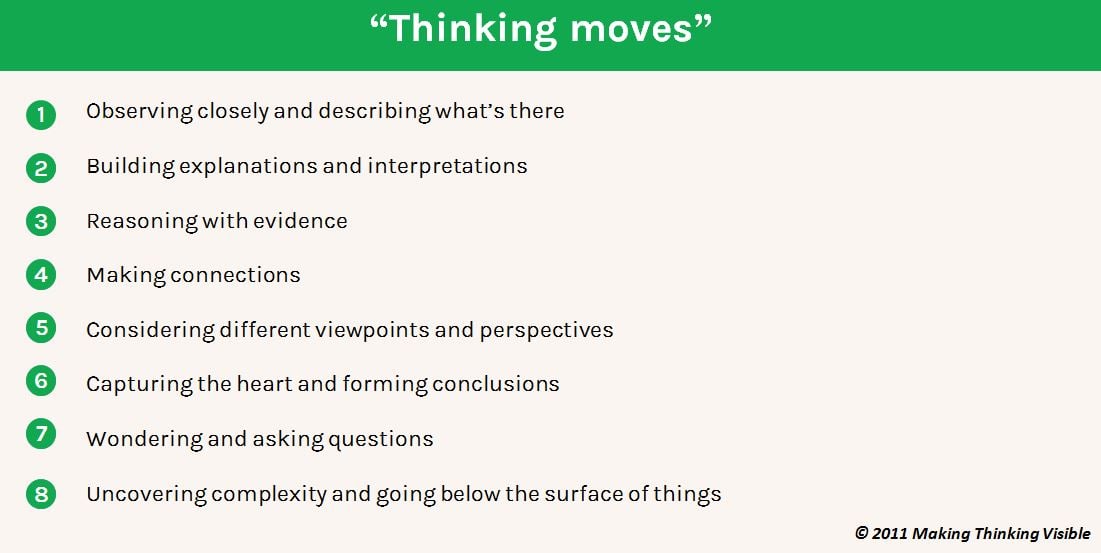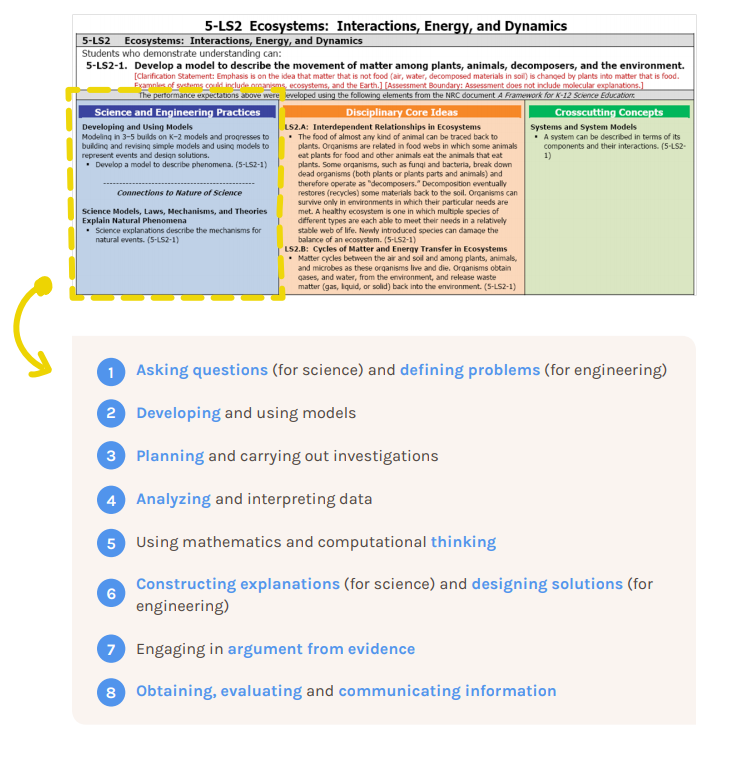The Next Generation Science Standards call for a significant shift in instruction: students need to actually think, to develop and refine their own ideas and the ideas of their peers.
This leads to a basic question that is surprisingly hard to answer: how do we think? When we ask students to think, what should really be going on in their minds?
The book “Making Thinking Visible” tackles these questions head-on, exploring how and why thinking is so important in the classroom.
As part of their research, the authors came up with eight thinking moves, what they call “high-leverage moves that serve understanding well.” These eight thinking moves are “integral to understanding and without which it would be difficult to say we had developed understanding.”

These thinking moves are particularly important in a next generation science classroom, where students need to engage with the three dimensions of the NGSS—the science and engineering practices, crosscutting concepts, and disciplinary core ideas.
The Three Dimensions
The disciplinary core ideas dimension is the most familiar one to most educators because it is the one most closely linked to content.
The other two dimensions add a depth to student learning that more traditional standards often lack. The crosscutting concepts, which include ideas such as cause and effect and energy and matter, “bridge disciplinary boundaries, uniting core ideas throughout the fields of science and engineering,” according to the standards.
The science and engineering practices dimension is most likely the newest for many science educators. The practices are those skills or behaviors that are core to the disciplines of science and engineering.

As students engage in the three dimensions of the NGSS, they must use some combination of the eight thinking moves because a primary goal of the NGSS is for students to develop the skills necessary to think critically and scientifically about the world around them, to be able to answer questions and solve problems using evidence.
For example, students will need to use the eight thinking moves to internalize and develop the science and engineering practices, to ask questions and define problems, to develop a model to understand something, to plan an investigation independently or to analyze and interpret the data that’s produced. Over time, these practices become habits that students will employ whenever they seek to make sense of the world around them through asking questions or solving problems.
Creating a Classroom Culture of Thinking
So how can educators create an environment where this kind of thinking takes place on a regular basis?
There are three key points necessary for creating a culture of thinking in the K-8 classroom.
- The learning experience must require continuous thinking on the side of the students AND the teacher.
This quote from 1978 by Vygotsky sums it up well: “Children grow into the intellectual life of those around them. School is no longer about the quick right answer but about the ongoing mental work of understanding new ideas and information." (emphasis added)
The important work of the teacher is to create a culture that nurtures the intellectual life of their students. Any culture is created through the behaviors, values, and expectations that are common and expected among the individuals in your tribe.
For example, at your school, is student thinking an important goal? Do students come to class knowing that the way to be scientists and engineers is by engaging in thinking moves?
One way to establish this culture of continuous thinking is by asking questions that require the creativity, analysis, and decision-making skills necessary in a next generation science classroom.
Read more about how to ask productive questions in a next generation classroom here.
- Ideas should be personal, concrete, and real to everyone.
In this next generation environment, learning is all about sense-making as students develop and use the three dimensions to answer questions and solve problems for themselves.
When students explore something that is real-world, there is an inherent relevance to their lives. They start to understand that connections they make in the classroom extend beyond the walls of the classroom, which means the skills they are developing also extend beyond the classroom.
They start to realize that they can apply the same skills they are developing in the classroom to the rest of their lives. This becomes a significant source of empowerment because it gives students the tools and skills to engage in science and engineering so that they can make sense of their environment and their lives.
- Ideas emanate from phenomena and are refined into a network of 3-dimensional understanding, all year long.
Phenomena are real-world, observable events. In a next generation classroom, they drive teaching and learning because uncovering how and why the phenomena occur provides the motivation for student learning.
Students work to make sense of the phenomena by using the science and engineering practices, crosscutting concepts, and disciplinary core ideas. Through this process, students learn that what they’re figuring out helps them make sense of the world around them, and that they have the necessary tools to seek out answers and solve problems for themselves.
The only way this can happen is through thinking.
As David Perkins, author of the book “Smart Schools,” wrote: "Learning is a consequence of thinking. Retention, understanding, and the active use of knowledge can be brought about only by learning experiences in which learners think about and think with what they are learning…. Far from thinking coming after knowledge, knowledge comes on the coattails of thinking. As we think about and with the content we are learning, we truly learn it."
It's important that we, as teachers, must acknowledge that when we reduce the amount of thinking that we ask of our students, we reduce the amount of learning as well.
Since learning is a consequence of thinking, thinking should be a tool that students can identify and understand that they have at their disposal and can use to solve problems, to form judgments, to answer questions, and to understand the world around them. That's the ultimate value here.
Education is more than the delivery of content. It's learning how to learn and how to think. When we learn how to learn and we learn how to think, that's something that serves us, not only in the classroom, but in everyday life.





